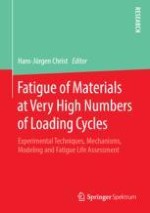2018 | OriginalPaper | Chapter
Influence of ceramic particles and fibre reinforcement in metal-matrix-composites on the VHCF behaviour. Part I: Experimental investigations of fatigue and damage behaviour
Authors : A. Illgen, M. Baaske, Felix Ballani, Anja Weidner, H. Biermann
Published in: Fatigue of Materials at Very High Numbers of Loading Cycles
Publisher: Springer Fachmedien Wiesbaden
Activate our intelligent search to find suitable subject content or patents.
Select sections of text to find matching patents with Artificial Intelligence. powered by
Select sections of text to find additional relevant content using AI-assisted search. powered by
High performance materials can be exposed to high frequency cyclic loading conditions during technical operation. In particular, small strains operating in the very high cycle fatigue (VHCF)-regime lead to accumulative damage. Thus, appropriate local deformation on discontinuities such as porosities, inclusions, and secondary phase reinforcements lead to crack initiation and to final fatal fracture. Concurrently, quite high requirements with regard to high number of cycles are demanded for many applications. Because of the desire for high strength at low density, fibre or particulate aluminium matrix composites (Al-MMCs) were developed. Fields of application of these light-weight, but expensive materials, are e.g. in the automobile industry (e.g. engine blocks, cylinder heads, brakes). The fatigue behaviour of Al-MMCs reinforced by alumina particles (15 vol. % Al2O3) or short fibres (20 vol. % Saffil) was extensively studied in earlier work in the low cycle fatigue (LCF) and high cycle fatigue (HCF) range. Therefore, present studies are focused on investigations in the very high cycle fatigue (VHCF) regime at stress amplitudes equal to or lower than 140 MPa to reach fatigue life of about 1010 cycles. All experiments were carried out using an ultrasonic fatigue testing device under symmetric loading conditions (R = – 1). Fatigue tests were complemented by in situ thermographic measurements to record the temperature of the whole specimen and to find “hot spots” indicating changes in microstructure and, therefore, the initiation or growth of cracks. Moreover, the resonant frequency as well as a nonlinearity parameter were evaluated to determine the initiation of damage. For a better understanding of the damage mechanism (matrix decohesion, matrix failure or failure of reinforcements) all fractured surfaces were investigated by scanning electron microscopy. The combination of these methods contributes to a better understanding of underlying mechanisms of damage in aluminium matrix composites.
